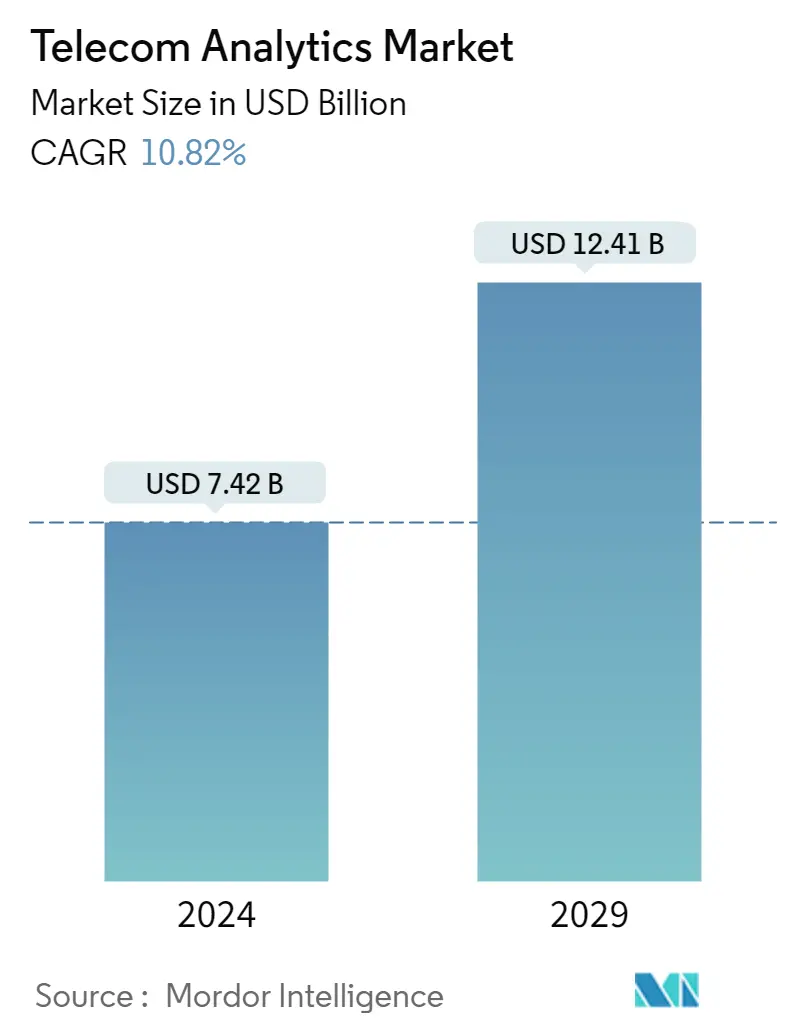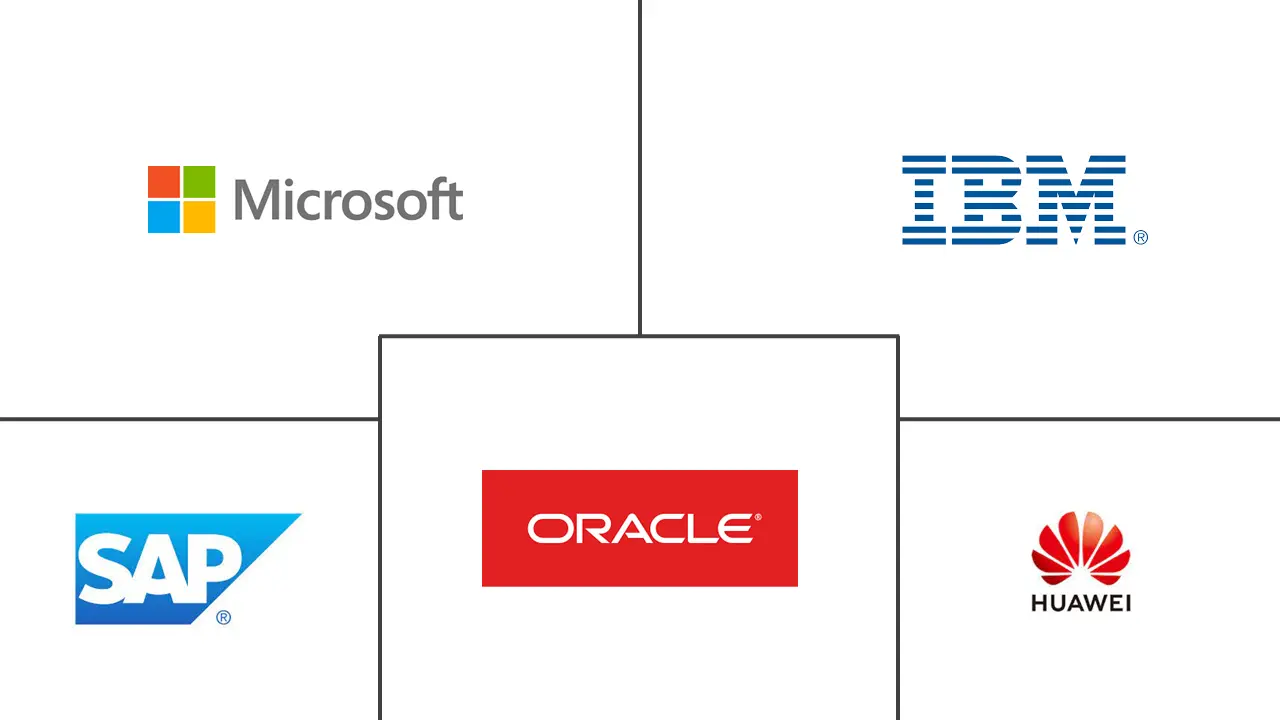Market Size of Telecom Analytics Industry

| Study Period | 2019 - 2029 |
| Market Size (2024) | USD 7.42 Billion |
| Market Size (2029) | USD 12.41 Billion |
| CAGR (2024 - 2029) | 10.82 % |
| Fastest Growing Market | Asia Pacific |
| Largest Market | North America |
| Market Concentration | Low |
Major Players
*Disclaimer: Major Players sorted in no particular order |
Telecom Analytics Market Analysis
The Telecom Analytics Market size is estimated at USD 7.42 billion in 2024, and is expected to reach USD 12.41 billion by 2029, growing at a CAGR of 10.82% during the forecast period (2024-2029).
The need for reducing churn is more important than ever, as the competition is increasing with the incidence of new entrants, who provide lucrative deals that are generally inexpensive than the incumbents. In addition, the increasing amount of unstructured and structured data requires effective analysis to get more profound insights into customer behavior and preferences. Real-time service usage patterns motivate these companies to adopt analytics.
- The telecom analytics market combines various sophisticated business intelligence (BI) technologies that satisfy the complex demands of the telecom industry. These include developing sales, reducing churn and deception, enhancing risk management, and decreasing operational costs. Hence, telecom organizations are adopting advanced analytics-driven data solutions for faster and simpler processing of only relevant data, helping them achieve timely and accurate insights using network analytics such as data mining and predictive analytics.
- Moreover, the telecommunications industry is entering a new era and increasing need for a new customer focus - enterprises instead of consumers, new technologies in 5G and the cloud, and fundamentally new ways of working to deliver agile, faster services using analytics and data science. As of January 2023, the GSA reports that there are 243 commercial 5G deployments worldwide, with 112 operators investing in standalone 5G. This commercialization will lead to new B2B and B2B2X applications. In doing so, operators need to ensure that they can serve these customers beyond simply expanding capacity or flexibly changing service levels and resources.
- For instance, in February 2023, Oracle Corporation announced to release the second application in our Network Analytics portfolio, the Oracle Network Analytics Data Director which enables operators to flexibly integrate their 5G core into their existing operational tools, even for network functions that are not provided by Oracle. Oracle Communications Network Analytics Data Director basically ingests traffic from various sources such as Oracle 5G network functions such as Service Communication Proxy (SCP) and Network Repository Function (NRF) and distributes it to subscriber applications.Both incoming and outgoing data are encrypted, allowing users to guarantee end-to-end data transfer.
- Telecom analytics service is expected to be hosted on the cloud because of the large number of mobile users worldwide. Hence, cloud hosting is also set to expand further due to the continuous rise in the consumer base. Thus, the adoption of this technology by communications service providers (CSPs) is growing significantly.
- Telecom analytics has been helping communications service providers (CSPs) to boost productivity, enhance customer satisfaction, and grow revenues. For instance, Nokia Corporation's Nokia AVA analytics and insights helped many leading telecom companies re-engineer their market measurement products. POST Luxembourg, a Tier-1 service provider, used Nokia AVA to proactively identify and solve 97% of network issues before they could affect subscribers. Moreover, Hutchison 3 Indonesia improved the spectral efficiency of its network by 17%. Additionally, Vodafone solves network issues up to 30% faster by using Bell Labs machine learning algorithms that detect anomalies and help automate root cause analysis.
- The improvements in data infrastructure have enabled the use of analytics in the telecom industry, owing to which data-rich carriers can yield meaningful intelligence to transform their businesses. Telecom analytics allows pages to merge and analyze customer data related to spending and plans and behaviour data like internet usage or duration of networking activities.
- Due to the proliferation of smart devices and the increasing use of IP networks, the telecom industry is experiencing a resurgence of communications fraud. As attacks can come from any source, scam has emerged as the most troublesome problem for the telecom market. Due to this, authorities are initiating regulations for the telecoms sector safety. In India, the Telecom Regulatory Authority of India has issued stringent rules and penalties for failing to meet the voice quality benchmark. It is expected to increase the demand for network analytics solutions in the country.
- During the COVID-19 pandemic outbreak, the overall utilization of telecom analytics has expanded. Due to the factors like the increased pressure on broadband caused by the ability to work from home, the rise in online streaming platforms, improved visibility of internal processes, and essential operations by telecom analytics, the demand for telecom analytics has grown during the active lockdown period.
Telecom Analytics Industry Segmentation
Telecom analytics is a type of business intelligence specifically applied and packaged to satisfy the complex needs of telecommunication organizations. Telecom analytics is aimed at decreasing operational costs and maximizing profits by increasing sales, reducing fraud, and improving risk management.
The Telecom Analytics Market is segmented by Application (Customer Analytics, Network Analytics, Market Analytics, Price Analytics, Service Analytics), Deployment (Cloud and On-premise), and Geography.
| By Application | |
| Customer Analytics | |
| Network Analytics | |
| Market Analytics | |
| Price Analytics | |
| Service Analytics | |
| Other Applications |
| By Deployment | |
| Cloud | |
| On-premise |
| By Geography | ||||||
| ||||||
| ||||||
| ||||||
|
Telecom Analytics Market Size Summary
The telecom analytics market is poised for significant growth, driven by the increasing need for telecom companies to reduce customer churn and enhance service offerings amidst rising competition and the influx of new entrants. As telecom organizations grapple with vast amounts of structured and unstructured data, the adoption of advanced analytics-driven solutions has become crucial. These solutions enable companies to gain deeper insights into customer behavior and preferences, optimize network performance, and improve risk management. The integration of real-time service usage patterns and predictive analytics is helping telecom providers streamline operations, reduce costs, and enhance customer satisfaction. The shift towards enterprise-focused services, coupled with the deployment of 5G and cloud technologies, is further propelling the demand for telecom analytics, as companies seek to deliver agile and efficient services.
North America is expected to hold a significant share of the telecom analytics market, fueled by high investments in business intelligence solutions and a competitive telecommunications landscape. The region's advanced IT infrastructure and strategic mergers and acquisitions are contributing to market growth. The increasing adoption of cloud-based solutions, driven by the rise in smartphone users and the need to combat communications fraud, is also boosting the market. Key players in the industry, such as Oracle, IBM, and Nokia, are actively enhancing their analytics offerings through collaborations and technological advancements. These developments are enabling telecom companies to improve customer experiences, reduce churn, and drive revenue growth, positioning them for success in a rapidly evolving market.
Telecom Analytics Market Size - Table of Contents
-
1. Market Insights
-
1.1 Market Overview
-
1.2 Value Chain Analysis
-
1.3 Industry Attractiveness - Porter's Five Forces Analysis
-
1.3.1 Threat of New Entrants
-
1.3.2 Bargaining Power of Buyers
-
1.3.3 Bargaining Power of Suppliers
-
1.3.4 Threat of Substitute Products
-
1.3.5 Intensity of Competitive Rivalry
-
-
1.4 Impact of Covid-19 on the Market
-
1.5 Market Dynamics
-
1.5.1 The surge in need for churn reduction
-
1.5.2 Increasing Vulnerability to Fraudulent Activities
-
-
1.6 Market Restraints
-
1.6.1 Lack of Awareness Among Telecom Operators
-
-
-
2. MARKET SEGMENTATION
-
2.1 By Application
-
2.1.1 Customer Analytics
-
2.1.2 Network Analytics
-
2.1.3 Market Analytics
-
2.1.4 Price Analytics
-
2.1.5 Service Analytics
-
2.1.6 Other Applications
-
-
2.2 By Deployment
-
2.2.1 Cloud
-
2.2.2 On-premise
-
-
2.3 By Geography
-
2.3.1 North America
-
2.3.1.1 United States
-
2.3.1.2 Canada
-
-
2.3.2 Europe
-
2.3.2.1 United Kingdom
-
2.3.2.2 Germany
-
2.3.2.3 France
-
2.3.2.4 Rest of Europe
-
-
2.3.3 Asia Pacific
-
2.3.3.1 China
-
2.3.3.2 India
-
2.3.3.3 Japan
-
2.3.3.4 Rest of Asia Pacific
-
-
2.3.4 Rest of the World
-
2.3.4.1 Latin America
-
2.3.4.2 Middle East and Africa
-
-
-
Telecom Analytics Market Size FAQs
How big is the Telecom Analytics Market?
The Telecom Analytics Market size is expected to reach USD 7.42 billion in 2024 and grow at a CAGR of 10.82% to reach USD 12.41 billion by 2029.
What is the current Telecom Analytics Market size?
In 2024, the Telecom Analytics Market size is expected to reach USD 7.42 billion.

